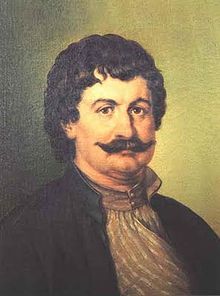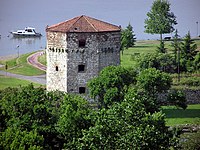Rigas Velestinlis
Rigas Velestinlis , Greek Ρήγας Βελεστινλής (* 1757 in Velestino ; † June 24, 1798 in Belgrade ), also called Rigas Pheraios or Rigas Fereos after the ancient Greek name of his native town ( Pherai ) , was a Greek writer and revolutionary .
Along with Adamantios Korais, Velestinlis is considered to be the pioneer of the Greek revolution of 1821, which ultimately led to Greek independence from the Ottoman Empire . His vision was independence from the Ottoman Empire in the form of a federation of the countries of Southeast Europe. Today, his portrait adorns the Greek 10 cents - coins .
Life

1776 he left the Thessaly Velestino (before that he worked as the teacher in Kissos , Pelion active) and went to Konstantin Opel , where he secretary of Phanariots Alexandros Ypsilanti was that at that time as an interpreter at Sultan I. Abdulhamid served. Ypsilantis felt obliged to act as a mentor to the young Velestinlis and above all endeavored to promote his intellectual development. In the following years Velestinlis learned the German, French and Italian languages as part of his work for the dragomaniac .
From 1788 to 1790 Velestinlis worked as the secretary of the Phanariote Nikolaos Mavrogenis , who administered the Principality of Moldova . Here he made himself familiar with French literature and philosophy , especially with Rousseau and Voltaire . At the time of the outbreak of the French Revolution he was in Bucharest , where the Greek intellectuals living there inspired his later life's work with theories of an uprising by the Greeks and other Balkan peoples against the Ottoman rule based on the principles of the French Revolution.
Taken into boundless enthusiasm by the idea of a revolution of the Enlightenment against the feudal Ottoman Empire, he made it his task to convince other supporters and donors of this vision in order to ultimately contribute to its realization. For this reason, he began his travels in Central and Western Europe . Above all, he traveled to those countries in which the Greeks of the diaspora had formed larger communities. Probably the most important reason for his operations abroad was the fact that most of the Greek intelligentsia had migrated there from the Ottoman Empire.
One of the most important stops on his travels was Vienna in 1796. Here he composed revolutionary songs, some of which later became part of the Greek cultural heritage . As elsewhere before, he sparked a passionate discussion among Greek students and traders. He also had many revolutionary publications printed and distributed here, including the “ Charter of Hellas ”. This charter was a draft constitution for a democratic , federal Balkan state independent from the Ottoman Empire. In his draft constitution, Velestinlis assigned the Greeks a leading role in a federation that also consisted of other, non-Greek Balkan peoples . Even if a chauvinistic attitude towards the non-Greek Balkan peoples can not be proven, the principle of equality, which was taken from the French Revolution, was put into perspective with this leadership role.
In 1798 he traveled to Trieste , where he was arrested shortly after his arrival. As a separatist and revolutionary , he was quickly handed over by the Austrian to the Ottoman authorities in Belgrade. On June 24, 1798, Velestinlis was executed there.
However, his death could not prevent his posthumous spiritual influence on like-minded people in the Balkans. This influence, the vision of an independent state modeled on and the ideals of the French Revolution, the Greeks tried a few decades later, through their uprising in 1821 against the Sublime Porte .
In 1930 the Rhigasgasse in Vienna- Hernals (17th district) was named after him. The Greek community in whose area he was born has been called Rigas Fereos since 2011 .
swell
- Émile Legrand (ed.): Documents inédits concernant Rhigas Vélestinlis et ses compagnons de martyre, tirés des archives de Vienne. Tirage à part de l'annuaire de la Société Historique de Grèce, Paris 1892.
- Polychronis Enepekidis : Rigas - Ypsilantis - Kapodistrias (= Pige ke erefne peri tis istorias tou Ellinismou apo tou 1453 , volume 2), Athens 1967 (Greek).
literature
- Christopher M. Woodhouse : Rhigas Velestinlis. The Proto-Martyr of the Greek Revolution. Denise Harvey Publications, Limni 1995, ISBN 960-7120-08-6 .
- Julia Chatzipanagioti: sadness at the sight of shackles. On the 200th anniversary of the death of the reconnaissance and revolutionary Rigas Velestinlis (1757–1798). In: Chronika. Volume 6, 1998, pp. 4-11 and 26-29.
- Helmut Schareika: Rigas Velestinlís, the Greek uprising 1821 ff. And the current crisis in Greece. Published in: kultuRRevolution 66/67 (June 2014), subject: krisenlabor greece http://www.klartext-verlag.de/ .
Web links
- Literature by and about Rigas Velestinlis in the catalog of the German National Library
| personal data | |
|---|---|
| SURNAME | Velestinlis, Rigas |
| ALTERNATIVE NAMES | Kyriazis, Antonios; Ferreos, Rigas; Pheraios, Rigas; Rigas, Konstantinos; Βελεστινλής, Ρήγας (Greek) |
| BRIEF DESCRIPTION | Greek writer and revolutionary |
| DATE OF BIRTH | 1757 |
| PLACE OF BIRTH | Velestino |
| DATE OF DEATH | June 24, 1798 |
| Place of death | Belgrade |






